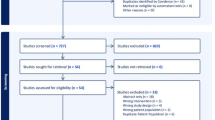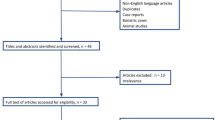Abstract
Background
Poly-4-hydroxybutyrate (P4HB) is a bioabsorbable mesh with a non-adhesive coating on one side that is being used to reinforce the hiatus during hiatal hernia repair; however, there is limited data regarding its use. The aim of this study was to investigate outcomes after hiatal hernia repair using this mesh at our institution and through a review of the literature.
Methods
An institutional review board-approved prospective database was retrospectively reviewed for all patients undergoing hiatal hernia repair from April 2018 to December 2022. A systematic review with meta-analysis was conducted to evaluate outcomes using P4HB coated mesh.
Results
In our institutional cohort, there were 230 patients (59 males; 171 females) with a mean follow-up of 20 ± 14.6 months. No mesh-related complications occurred. Hernia recurrence was diagnosed in 11 patients (4.8%) with a median time to recurrence of 16 months. In the systematic review, 4 studies with 221 patients (76 males; 145 females) were included. Median follow-up ranged from 12 to 27 months. Recurrence rate in these studies was reported from 0 to 8.8%, with a total of 12 recurrences identified. Like our institutional cohort, no mesh-related complications were reported. After our recurrences were combined with those from the systematic review, a total of 23 recurrences were included in the meta-analysis. Our meta-analysis revealed a low recurrence rate following hiatal hernia repair with P4HB coated mesh (incidence rate per 100 person-years, 2.82; 95% confidence interval, 1.60, 4.04).
Conclusion
P4HB coated mesh is safe and effective for hiatal hernia repairs.



Similar content being viewed by others
References
Rajkomar K et al (2023) Laparoscopic large hiatus hernia repair with mesh reinforcement versus suture cruroplasty alone: a systematic review and meta-analysis. Hernia 27:849–860
Clapp B et al (2022) Does the use of bioabsorbable mesh for hiatal hernia repair at the time of bariatric surgery reduce recurrence rates? A meta-analysis. Surg Obes Relat Dis 18(12):1407–1415
Watkins JR et al (2018) Biologic keyhole mesh in hiatal hernia repair. JSLS 22(1):e2017.00086
Dubina ED et al (2020) Predictors of morbidity and mortality in complex paraesophageal hernia repair: a NSQIP analysis. Am Surg 85(10):1189–1193
Inaba CS et al (2022) Characteristics and outcomes of patients undergoing paraesophageal hernia repair with selective use of biologic mesh. Surg Endosc 36(2):1627–1632
Oelschlager BK et al (2006) Biologic prosthesis reduces recurrence after laparoscopic paraesophageal hernia repair: a multicenter, prospective, randomized trial. Ann Surg 244(4):481–490
Oelschlager BK et al (2011) Biologic prosthesis to prevent recurrence after laparoscopic paraesophageal hernia repair: long-term follow-up from a multicenter, prospective, randomized trial. J Am Coll Surg 213(4):461–468
Watson DI et al (2015) Laparoscopic repair of very large hiatus hernia with sutures versus absorbable mesh versus nonabsorbable mesh: a randomized controlled trial. Ann Surg 261(2):282–289
Abdelmoaty WF et al (2020) Combination of surgical technique and bioresorbable mesh reinforcement of the crural repair leads to low early hernia recurrence rates with laparoscopic paraesophageal hernia repair. J Gastrointest Surg 24(7):1477–1481
Aiolfi A et al (2022) Medium-term safety and efficacy profile of paraesophageal hernia repair with Phasix-ST® mesh: a single-institution experience. Hernia 26(1):279–286
Konstantinidis H, Charisis C (2022) Surgical treatment of large and complicated hiatal hernias with the new resorbable mesh with hydrogel barrier (Phasix™ ST): a preliminary study. J Robot Surg. https://doi.org/10.1007/s11701-022-01406-9
Panici Tonucci T et al (2020) Safety and efficacy of crura augmentation with phasix ST mesh for large hiatal hernia: 3-year single-center experience. J Laparoendosc Adv Surg Tech 30(4):369–372
Barnett A (2014) SF-36 health survey. In: Michalos AC (ed) Encyclopedia of quality of life and well-being research. Springer, Dordrecht, pp 5939–5940
Fair L et al (2023) Comparison of long-term quality of life outcomes between endoscopic vacuum therapy and other treatments for upper gastrointestinal leaks. Surg Endosc 37:6538–6547
Stoikes NFN et al (2017) Characterization of host response, resorption, and strength properties, and performance in the presence of bacteria for fully absorbable biomaterials for soft tissue repair. Hernia 21(5):771–782
Kamarajah SK et al (2021) Bioabsorbable mesh use in midline abdominal wall prophylaxis and repair achieving fascial closure: a cross-sectional review of stage of innovation. Hernia 25(1):3–12
Date AR et al (2021) Quality of life after giant hiatus hernia repair: a systematic review. J Minim Access Surg 17(4):435–449
Author information
Authors and Affiliations
Contributions
PA, MW, LF, DT, EP, SR, GO, BA, and SL contributed to study conception, study design, and data acquisition. GO performed data analysis and interpretation. PA, LF, and SL drafted the original manuscript. All authors provided final approval of the submitted version of the manuscript.
Corresponding author
Ethics declarations
Disclosures
Lucas Fair, Marc, Ward, Preston Adhikari, Daniel Tran, Emerald Pina, Sudha Ramakrishnan, Gerald Ogola, Bola Aladegbami, and Steven Leeds have no conflicts of interest or financial ties to disclose.
Additional information
Publisher's Note
Springer Nature remains neutral with regard to jurisdictional claims in published maps and institutional affiliations.
Rights and permissions
Springer Nature or its licensor (e.g. a society or other partner) holds exclusive rights to this article under a publishing agreement with the author(s) or other rightsholder(s); author self-archiving of the accepted manuscript version of this article is solely governed by the terms of such publishing agreement and applicable law.
About this article
Cite this article
Fair, L., Ward, M., Adhikari, P. et al. Coated poly-4-hydroxybutyrate (Phasix ST™) mesh is safe and effective for hiatal hernia repair: our institutional experience and review of the literature. Surg Endosc 38, 830–836 (2024). https://doi.org/10.1007/s00464-023-10604-x
Received:
Accepted:
Published:
Issue Date:
DOI: https://doi.org/10.1007/s00464-023-10604-x




